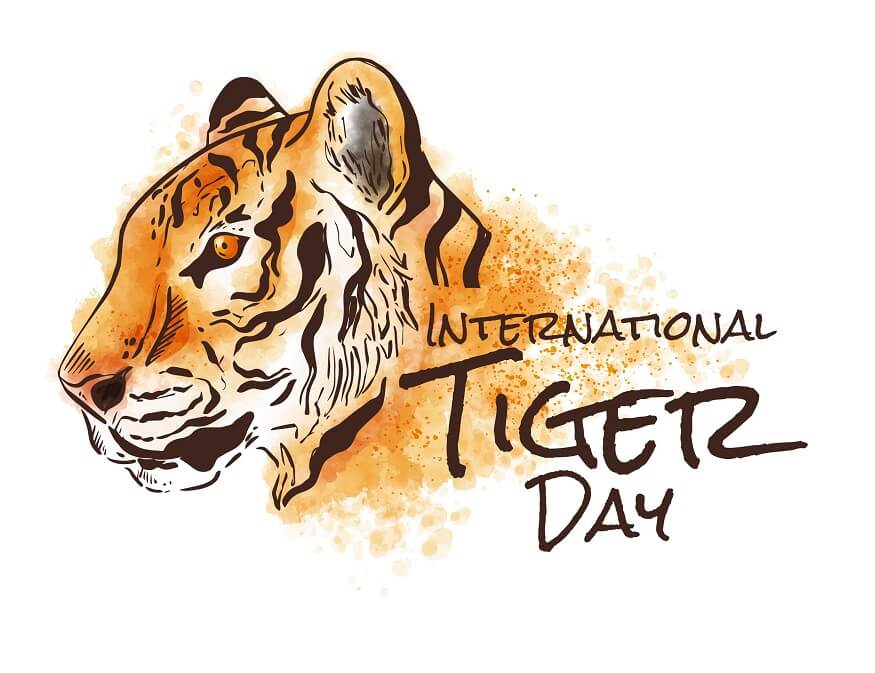International Tiger Day, observed worldwide on July 29, has become a powerful symbol of wildlife conservation and ecological balance, and in 2025, India stands at the forefront of this global movement. Home to approximately 3,682 wild tigers—about 75% of the global population—India not only celebrates these majestic big cats but also exemplifies a remarkable conservation success story that inspires the world. Marked by pan-national activities, government initiatives, community engagement, and eco-tourism, this year’s International Tiger Day underscores the country’s pivotal role in ensuring the future of tigers and their habitats.
India’s commitment to tiger conservation goes beyond numbers; it reflects the country’s deep cultural reverence for the majestic big cat. Tigers have been a part of Indian mythology, folklore, and religious symbolism for centuries, inspiring awe and respect among local communities. This cultural connection has been leveraged effectively by conservationists to foster a protective attitude towards tigers and their habitats. Festivals, community storytelling, and educational programs often highlight the tiger’s symbolic importance, creating a sense of stewardship among people living alongside tiger reserves.
The role of local and indigenous communities in tiger conservation cannot be overstated. These groups possess invaluable traditional knowledge about forest ecosystems and animal behavior, which enhances modern scientific efforts. Many reserves have integrated community-led patrols, anti-poaching initiatives, and habitat management plans that actively involve villagers, creating livelihood opportunities and reducing human-animal conflicts. Such inclusive approaches have proved instrumental in sustaining tiger populations and promoting coexistence.
In addition to traditional conservation methods, India has embraced cutting-edge technology in monitoring its populations. Camera traps, GPS collars, and drone surveillance have allowed wildlife managers to track movements accurately and detect threats in real time. Advances in artificial intelligence and machine learning are being used to analyze vast amounts of data, predicting poaching hotspots and optimizing patrol deployment. This integration of science and technology has drastically improved the efficiency and effectiveness of anti-poaching efforts.
Another important aspect of tiger conservation in India is the focus on habitat connectivity. Tigers require large territories to roam and breed, and fragmentation of forest habitats poses a serious threat. India has actively been developing wildlife corridors that link isolated reserves, allowing to migrate, find mates, and maintain genetic diversity. These green corridors also help mitigate inbreeding and reduce human-tiger conflicts by providing safe passages away from human settlements.
The success of Project Tiger, launched in 1973, remains one of India’s most celebrated conservation initiatives. It laid the groundwork for creating reserves with strict protection policies and dedicated management structures. Over the decades, Project Tiger has evolved to include community development, scientific research, and international cooperation components. Its success has not only boosted numbers but has also become a flagship model for wildlife conservation globally, showcasing how sustained political will and public participation can bring an endangered species back from the brink.

India’s Tiger Triumph: Doubling the Population in Two Decades
According to Union Environment Minister Bhupender Yadav, India’s population has surged from around 1,411 two decades ago to an estimated 3,682 in 2025, an achievement credited to robust governance, grassroots participation, and strategic habitat management. This sharp rise is especially impressive given the developmental pressures and human-wildlife conflicts that characterize the Indian subcontinent. India’s model uniquely blends protected reserves with open, human-shared landscapes, enabling to roam and breed in connected habitats while facilitating coexistence with local communities.
Celebrating the Big Cats: Major Events and Awareness Campaigns Across India
Across all 58 tiger reserves, from the iconic Ranthambore and Jim Corbett to the unique Sundarbans, festivities abound. Wildlife officials have launched educational programs, eco-tourism safaris, and conservation talks, aimed at raising awareness of ecology and the ongoing need to protect critical habitats. Safaris and photography contests engage tourists and locals alike in celebrating tiger culture, while community-led plantation drives across reserves plant thousands of indigenous trees to restore and expand tiger corridors.

International Theme 2025: Indigenous Peoples and Local Communities at the Heart
The theme for International Tiger Day 2025—“Securing the future of Tigers with Indigenous Peoples and Local Communities at the heart”—reflects a global recognition of the indispensable role that forest-dwelling peoples and villages play in conservation. Across India, many tribal communities regard the as sacred, weaving the animal into their cultural and spiritual lives. Recent years have seen increased participation from these communities in conservation programs, fostering mutual trust and sustainable management practices that benefit both tiger populations and human livelihoods.
Technological Advances and Anti-Poaching Efforts Enhance Protection
Sophisticated monitoring tools—such as camera traps, drone surveys, and AI-driven detection systems—have revolutionized population tracking and habitat management in India. Anti-poaching patrols have intensified, with forest guards equipped to address illegal hunting and wildlife trafficking. In regions where tiger-human conflicts occasionally erupt, government-supported compensation schemes ensure families affected by encounters receive prompt assistance, a key component in maintaining tolerance and reducing retaliatory killings.
Tiger Reserves as Pillars of Biodiversity and Ecotourism
India’s sanctuaries are not only refuges for these apex predators but also biodiversity hotspots that support countless flora and fauna. The country’s largest reserves, including Jim Corbett—the first national park and reserve in India—and Sundarbans, famed for its mangrove ecology, welcome tourists eager to experience wildlife safaris and boat rides. These eco-tourism ventures contribute significantly to local economies and conservation funding, creating incentives for environmental stewardship among rural populations.
Voices from the Ground: Honoring Conservation Heroes and Communities
International Day celebrations include recognition for frontline forest guards, researchers, and wildlife rescuers whose tireless efforts ensure the survival of tigers. Grassroots conservationists from West Bengal to Madhya Pradesh are lauded for their roles in rescue operations, conflict resolution, habitat restoration, and awareness-building. Such honors reinforce community pride and motivate continued dedication to protecting India’s natural heritage.
Global Leadership and Model for Coexistence
India’s conservation journey offers lessons extending beyond its borders. While some countries witness dwindling numbers, India’s success demonstrates that coexistence with large carnivores is possible, even amid dense human populations. Its integrated approach combining secure breeding reserves with multifunctional open landscapes contrasts with rigid conservation tactics elsewhere, positioning India as a leader in innovative, inclusive wildlife preservation.

Looking Forward: Challenges and Commitments
Despite gains, challenges remain—habitat fragmentation, climate change, human-wildlife conflicts, and poaching continue to threaten delicate ecosystems. Conservationists advocate for ongoing government support, stronger law enforcement, expanded corridors, and community engagement to ensure numbers keep rising sustainably. International Day 2025 serves as a clarion call, reminding policymakers and the public alike that safeguarding tigers is inseparable from protecting forests, water sources, and rural livelihoods.
India’s vibrant celebrations, from Kolkata’s citywide awareness drives to Jharkhand’s experimental eco-tourism initiatives, embody the collective resolve to secure a thriving future for the and all life it symbolizes. As the world joins hands this July 29, India proudly roars its leadership and commitment—not only to the big cats but to the enduring balance between humans and nature on this planet.
Eco-tourism around reserves has become a vital tool for both conservation funding and awareness generation. Carefully managed tourism allows people from across the country and internationally to experience in their natural settings, raising appreciation and support for conservation. Revenues from tourism contribute directly to habitat protection and benefit local communities through employment and infrastructure development. However, strict guidelines are enforced to ensure tourism does not disturb wildlife or degrade habitats, maintaining balance between economic benefits and ecological health.
The increasing population has also brought new challenges, especially regarding human-wildlife conflict. As numbers grow, encounters with humans near forest fringes have increased, sometimes resulting in loss of life, livestock, and property. India has implemented compensation schemes for affected families, and rapid response teams intervene to relocate problem sensitively. These measures are crucial for maintaining public support for conservation and preventing retaliatory actions against tigers.
Educational outreach plays a pivotal role in shaping public attitudes towards and wildlife conservation overall. Schools, colleges, and community centers across India conduct special programs on International Day and beyond, teaching children and adults about the ecological significance of and the need for sustainable coexistence. Awareness campaigns also address myths and fears surrounding tigers, replacing them with factual knowledge and empathy.
India’s conservation story is one of hope amid global biodiversity decline. While many countries have seen drastic reductions in big cat populations, India has demonstrated that dedicated national effort, strong policy frameworks, and grassroots participation can reverse negative trends. The nation’s approach—combining scientific innovation, cultural inclusion, and economic incentives—is increasingly recognized as a model worthy of replication in other parts of the world where large carnivores and humans share space.
Looking ahead, conservation in India remains a dynamic challenge requiring continued vigilance, adaptability, and collaboration. Climate change, habitat loss, and increasing human populations impose persistent pressures on habitats. Scientists, policymakers, and communities are working together to devise adaptive management strategies that ensure and humans can thrive together. International Day 2025 is not just a celebration but a powerful reminder that conservation is an ongoing journey—one that demands renewed commitment and collective action to secure the roar of tigers for generations to come.
Follow: International Tiger’s Day

